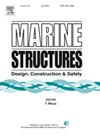波浪作用下浮动层合结构水弹塑性响应的数值研究
IF 5.1
2区 工程技术
Q1 ENGINEERING, CIVIL
引用次数: 0
摘要
基于有限元模拟软件ABAQUS中的耦合欧拉-拉格朗日(CEL)数值方法,建立了求解浮动层合结构的波浪-结构弹塑性耦合问题的波浪水槽数值模型。采用物理生波方式,通过控制刚性板运动形成波浪,通过建立高动粘系数阻尼区实现水波耗散。针对浮体结构的水弹塑性问题,进一步提出并验证了一种双向流固耦合数值方法。通过对均质浮式结构的物理实验和对叠层浮式结构的理论模型验证了双向相互作用方法的有效性。最后,结合复合材料形态、加筋构件特性、结构层合特性和水动力载荷,建立了基于CEL-FEM方法的多尺度数值框架,直观地模拟了波浪作用下浮动层合结构的水弹塑性响应。作为一个例子,浮动层合结构(FLS)最初被设计为由下部可变形层和上部高刚度增强层组成。在多尺度数值框架的基础上,通过改进材料细观组成和增强构件宏观参数,优化了FLS的初始设计,实现了结构性能的增强。通过充分模拟不同波浪条件下水波与结构弹塑性的相互作用过程,分析水动力特性、塑性耗散能、流体域应力分布和结构响应的演变,阐明水弹塑性问题的机理和认识。本文章由计算机程序翻译,如有差异,请以英文原文为准。
Numerical investigation on hydro-elastoplastic responses of floating laminated structures under wave action
Based on the Coupled Eulerian-Lagrangian (CEL) numerical method in Finite Element Modelling (FEM) software ABAQUS, a numerical wave flume model was established to solve the wave-structural elastoplastic coupling problem of floating laminated structures. The physical wave-generating mode was adopted to form waves by controlling the motion of a rigid plate, and the water wave dissipation was realized by establishing a damping zone with high dynamic viscosity coefficients. A two-way fluid-structure coupling numerical approach was further proposed and verified for the hydro-elastoplastic problem of floating structures. The present two-way interaction approach was validated based on the previous physical test for the floating homogenous structures and the theoretical model for the floating laminated structures. Finally, combining the composite material configuration, reinforced member characteristic, structural laminated feature, and hydrodynamic loads, a multiscale numerical framework with the CEL-FEM approach was presented to intuitively simulate the hydro-elastoplastic responses of the floating laminated structures under wave action. As an illustration, a floating laminated structure (FLS) was initially designed to consist of the lower deformable layer and the upper high-stiffness reinforced layer. Based on the multiscale numerical framework, the initial design of FLS was optimized by ameliorating the material meso-composition and reinforced member macro-parameter to realize the structural performance enhancement. Fully simulating the interactive processes between water waves and structural elastoplasticity of the FLSs under different wave conditions, the mechanism and understanding of the hydro-elastoplastic problem was elucidated by analyzing the evolutions of the hydrodynamic characteristics, plastic dissipation energy, fluid domain stress distribution, and structural responses.
求助全文
通过发布文献求助,成功后即可免费获取论文全文。
去求助
来源期刊

Marine Structures
工程技术-工程:海洋
CiteScore
8.70
自引率
7.70%
发文量
157
审稿时长
6.4 months
期刊介绍:
This journal aims to provide a medium for presentation and discussion of the latest developments in research, design, fabrication and in-service experience relating to marine structures, i.e., all structures of steel, concrete, light alloy or composite construction having an interface with the sea, including ships, fixed and mobile offshore platforms, submarine and submersibles, pipelines, subsea systems for shallow and deep ocean operations and coastal structures such as piers.
 求助内容:
求助内容: 应助结果提醒方式:
应助结果提醒方式:


